TIK TOK SAVVY!
IS faculty and staff participated in an Undercover Spirit Day, today June 1. It’s a recent Tik Tok trend, where the faculty “know,” but students don’t! Today is “Secret Service Day!” Students were left wondering “why is everyone dressed in black today?”

Please support the good work of the Minisink Valley PTO and purchase an ULTIMATE DISCOUNT CARD!
This fundraiser concludes Saturday, June 7!
Get all the details via this link: https://www.ultimatefundraisinginc.com/discount-card-store/physical


Thank you to members of American Legion George Smith Post 1607 in Unionville and American Legion Auxiliary George Smith Unit 1607 for visiting the Intermediate School yesterday, May 21, to speak to all fifth-grade classes about the history and meaning of Memorial Day and what they did when they were active duty service personnel. Veterans also assisted in reciting the Pledge of Allegiance during morning announcements and even taught some fifth-graders the proper way to salute.
Thank you for visiting, and most importantly, thank you for your service!







Last evening's K-12 Art Show was beyond beautiful! It was bright, colorful, unique creative and full of pride by everyone who attended! We hope you were there!
Take a peek at some of our proud student-artists who were thrilled to show their works of art. Did you know that approximately 1,000 students had at least one piece of art on exhibit? THANK YOU to our awesome art faculty in our five buildings for their work to stage such a gorgeous exhibit! We appreciate you! See more photos on the district's Facebook page: https://www.facebook.com/MinisinkValleyCSD










CAN YOU HELP?
Mark your calendar, ONE WEEK FROM TODAY!
Giving back has never been cooler! Join us at Rita's on Dolson Avenue on Thursday, May 22 from 5 to 8 p.m. for a refreshing ice or custard and a portion of your money spent will go to the Tyrell J. Audian Memorial Scholarship at the High School!
TJ was a 2019 graduate and dedicated his life to our nation by enlisting in the Marines right out of high school. Tragically, TJ suddenly passed away during a training exercise with his unit. A track scholarship in his honor has been created in collaboration with High School yearbook. Please consider supporting of this worthy cause!

Sara Casillo’s and Mike Sirico's IS fifth-graders also had some recent goat fun when Minisink Valley parent Erin Ferraro brought her baby goat for them to meet….and take photos with. Who wouldn’t want a photo taken with a baby goat? Take a peek!
•The most recent 2022 statistics say that at that time, there were more than 1.1 billion goats living in the world, of which 150 million were in India.
• Goats were one of the first animals domesticated by humans, around 9,000 years ago, and they are known for their intelligence and agility, especially their ability to climb. They also have four-chambered stomachs, similar to cows, which helps them digest roughage.






Intermediate School runners "On your mark, get set, go!"
The Fastest Runner competition is set for Thursday, May 22! The deadline to register is Monday, May 19! We invite you to register your student to be part of this physically fun event! Scan the QR code for details!

Joan Giardina’s IS fourth-graders are creating line and color art inspired by American artist Charles McGee! Students are learning about patterns and relief sculptures that are 3D but meant to be viewed from the front, not from all angles.
During an almost eight-decade career, American artist Mr. McGee created paintings, assemblages, sculptures, public works, and a sense of community with his artwork and teaching throughout Detroit, Michigan. His enduring themes chronicled the Black experience and a love of nature that spanned an evolution across mediums.
This also included abstraction and many of his works focused completely on line and color, with no recognizable nods to figuration. Through his work, Mr. McGee focused on process rather than attempting to dictate a specific meaning or story.








MARK YOUR CALENDARS NOW!
One of the biggest district-wide events will take place Tuesday, May 20: The annual annual District Art Show/K-12 Exhibition! Over 400 student artists representing the High School, Middle School, Otisville Elementary the Intermediate School and the Elementary School will have work on display from 5 to 8 p.m. at the High School cafeteria and auditorium. It's always a gorgeous and vibrantly colorful exhibition, featured all kinds of art mediums! This exhibition is equally wonderful because of the smiles on the proud families and students! Please join us!

Congratulations to the 17 students who were recognized at the NYSAHPERD Catskill Zone Leadership Awards Ceremony, held this past Saturday at Wallkill High School!
This event honors top-grade-level students who exemplify excellence in fitness, leadership, and citizenship—key components of New York State learning standards.
These students were selected for their commitment to an active lifestyle, responsible behavior, leadership qualities, and contributions to their school community. While athletic ability is not a requirement, each honoree embodies the spirit of personal growth and positive influence.
"These students are role models who lead by example, showing us the power of character, effort, and service in physical education and beyond,” said Physical Education teacher Theresa Uhelsky, the organization’s past president.
Students honored were:
Middle School
• Mason King
• Ben Ziegler
• Lennox Addo
• Erin Arias
• Lyla LeBarbera
Otisville Elementary
• Leah Galligan
• Quinn Lattimer
• Luca Artola
• Eliya Graziano
Intermediate School
• Ella Manzie
• Madison Worden
• Jemma Marsala
• Charlotte Kohler
Elementary School
• James Santos
• Gary Boyajian
• Declan Barry
• Kaylee Jackler





When the weather cooperates, Physical Education teacher Leyla Johnson has been taking her intermediate and elementary students to the high school track to introduce them to track & field events.
Take a peek at her IS fourth-graders, who recently were introduced to the long jump!
In track & field, the long jump is a field event where athletes aim to jump as far as possible from a designated takeoff point (a board) into a sandpit. Athletes run along a runway, gathers speed, and then jumps, with the distance measured from the edge of the board to the closest point of body contact in the sandpit.





If it's Spring, it means the Intermediate School's Bike Club is back on the road!
Run by advisors Physical Education teacher Theresa Uhelsky and Security Officer Kevin Murphy, groups meet on Wednesdays and Fridays to learn how to become more proficient in bike riding. This includes important safety rules, too. And, everyone has a fun time!






Library class offers so many different learning opportunities! For example, Aimee Hardy’s IS third-graders recently completed another unit on internet safety. This includes conversations about the importance of being kind online, in addition to cyberbullying issues and what kinds of information they should keep private.
During this recent class, students learned about passwords and how to make unique ones that would be almost impossible for someone to figure out and use to access their data. Students were tasked with coming up with a phrase (as a password) that means something to them, such as “SAVE THE MANATEES.” Then, they were shown how to substitute letters with numbers and symbols to make their password becomes even more secure. So “SAVETHEMANATEES" becomes "5@w37n3W&u@t335."
Now they have a really great password that is hard to crack, and one that they can remember. Ask them about this!





Reminder: The 2025-26 student calendar has been available for everyone's use!
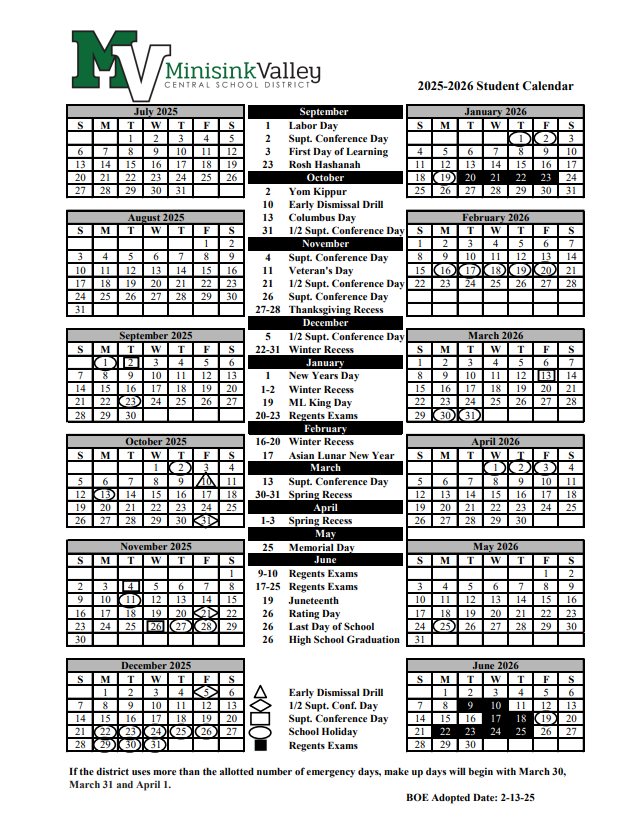
Last Friday's Hawaiian-themed IS Fifth-Grade Dance was a great evening which celebrated the fifth-grade class! Take a peek; and thank you to the IS PTO for organizing and running this event which will give these students such a wonderful memory!
See more photos on the district's Facebook page: https://www.facebook.com/MinisinkValleyCSD




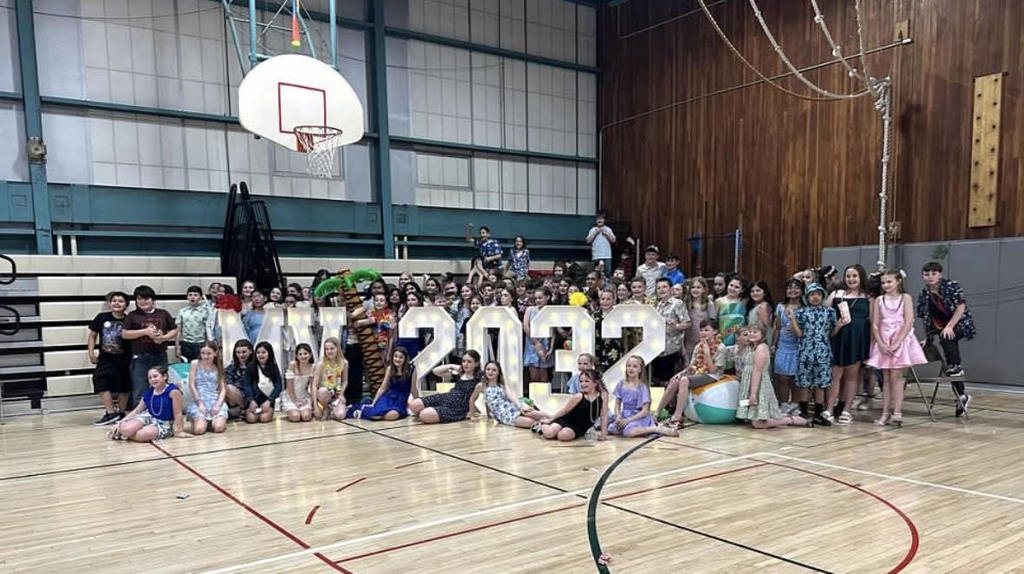

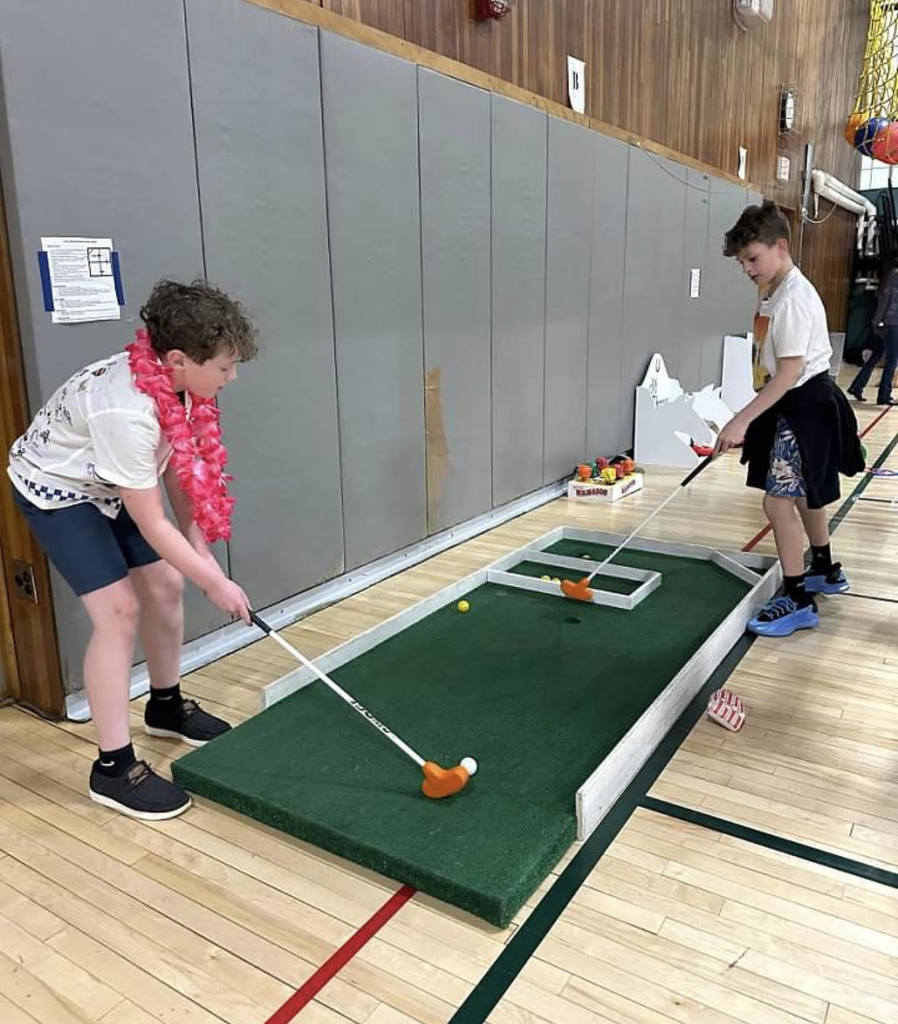

ADORABLE, EMPATHIC LEARNING
Sarah Casillo’s IS fifth-graders’ classroom has been home to nine honored guests, with the recent hatching of nine chicks! The initial 12 eggs were graciously donated to her class by Minisink Valley parent Erin Ferraro –thank you, Mrs. Ferraro!
Students watched a video about the egg incubation process and completed interactive quizzes so they understood what would be happening. For the prior three weeks, students were a variation of expectant relatives, happily looking forward to the chicks’ arrival! While some chicks hatched when school wasn’t in session, a few did while students were in class. Ms. Casillo said that was a magical experience for her students to observe!
“I've never seen the kids light up so much,” she said. “You can see on their faces how much love they have for these chicks. Based on this experience, I think all classrooms should have interactions with animals like this. It teaches social-emotional learning in a way the kids would never grasp without this experience. Having a living creature in your hand and knowing it's only a day old really touches the kids. They really stepped up and took such responsibility for making sure these chicks were healthy and happy.”
The chicks were named Midnight, Freckle, Kakalaka, Sunny, Oreo, Chirp, Mr. Clean, Mr. Sirico, and Chick “Chicksillo” Casillo.
Students, she added, had a first-hand experience in learning about empathy, how to care for someone else and even how to be gentle and stay calm.
“Some students were even afraid of them at first and by the end of the week, grew to adore them. It was a more emotional experience than academic,” said Ms. Castillo.
See more photos on the district's Facebook page: https://www.facebook.com/MinisinkValleyCSD










Briana Barrett and Nicole VanderDrift's IS fifth-graders have been learning about volume during their math lessons, as are all district fifth-graders.
This recent lesson focused on recognizing that volume can be measured by using unit cubes. They worked on measuring volumes by counting unit cubes that represent cubic centimeters, cubic inches and cubic feet. At the end of this lesson, students were able to compose and decompose right rectangular prisms to find their volume by using layers.
•In fifth-grade math, understanding that volume can be measured by using unit cubes is helpful because it provides a concrete, visual foundation for understanding the concept of volume as a measure of three-dimensional space, which then allows students to grasp more complex volume formulas later on.
•Composing and decomposing right rectangular prisms into layers to find their volume provides a visual and intuitive understanding of the concept of volume, allowing students to see how the area of the base, multiplied by the height (number of layers), equals the total volume.







BOWLING --- we’ve all played it! It’s an enjoyable game where players roll a somewhat heavy ball down a lane to try and knock down a group of 10 pins, aiming for a high score by accumulating points for each pin knocked down! Ross Potter’s and Anthony Licata’s IS physical education students are having a fun time developing their bowling skills during class (using not-so-heavy balls)!
•Bowling's history stretches back to ancient Egypt, with evidence of early forms of the game dating back to around 3,200 BC.
•Bowling has been banned or restricted in the past, such as in England during the reign of King Edward III who feared it distracted soldiers from archery practice, and in colonial America due to its association with gambling.
•While up to 17 pins have been used historically, the standard number of pins in modern bowling is 10.
•The heaviest bowling ball allowed is 23 pounds.
•Bowling can be a fun and accessible way to get exercise, with each hour of bowling burning anywhere from 150 to 300 calories.






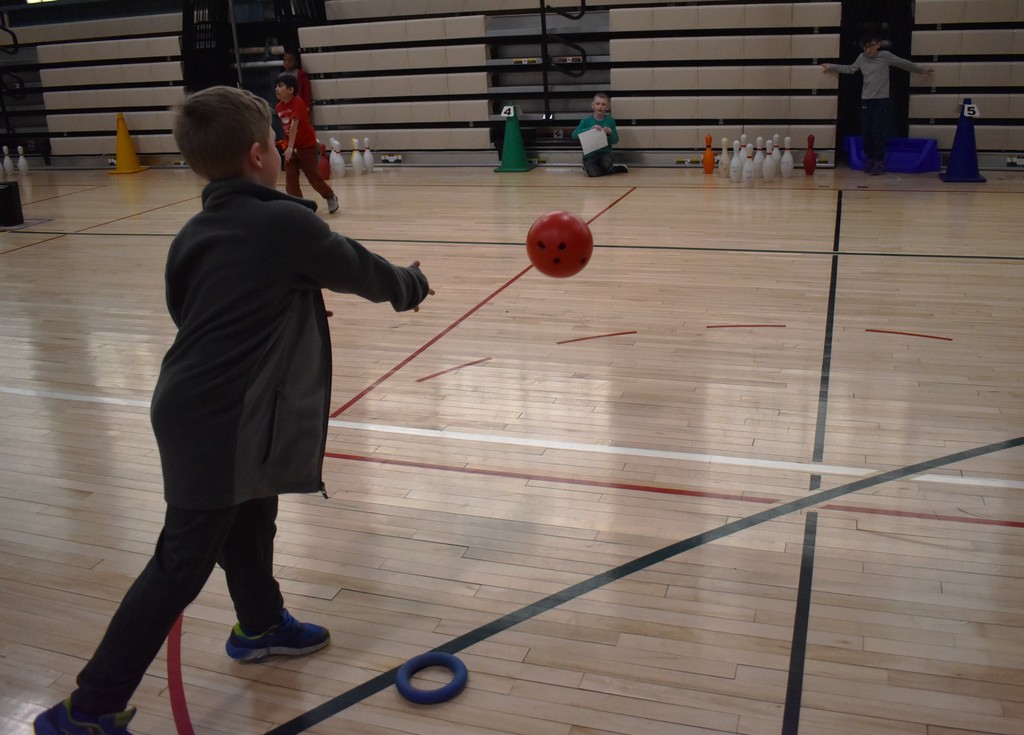



Karen Nicholson’s and Tara Guyette’s IS fifth-graders, like all district fifth-graders, have been reading "The Adventures of Don Quixote" in their ELA classes!
"The Adventures of Don Quixote" is often read in fifth-grade as part of a core knowledge curriculum to introduce students to a classic literary work, explore themes of fantasy and reality, and develop reading, writing, and critical thinking skills.
We’ve all probably read this book in our younger days! It’s the story about a man who loved to read about “the knighthood.” People actually thought he went crazy from reading so many books! He went on many crazy adventures with his friend, Sancho. At one point while they were approaching some windmills, Don Quixote actually thought they were giants and tried to fight them. All the while, Sancho was trying to tell him they were just windmills.
During their ELA unit work, Mrs. Nicholson and Mrs. Guyette set up a 'throne' in their classroom. A student who was 'knighted' was given the honor of sitting there with two members of their” court.”
Students also wrote an epitaph for Don Quixote at the end of the novel, written in the epitaph was written in a “Mad Lib” style. Mad Libs-style writing involves creating a story with blanks that are filled in with words of a specific part of speech (like nouns, verbs, adjectives) by someone else, which can also result in a humorous and unexpected narrative.
PLUS: Snack items always make learning fun! At the unit’s conclusion, the teachers gave their students “windmill” cookies and they decorated them as “giants!” (The cookies were happily devoured!)
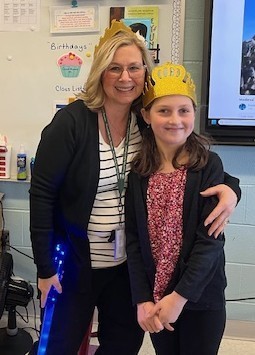


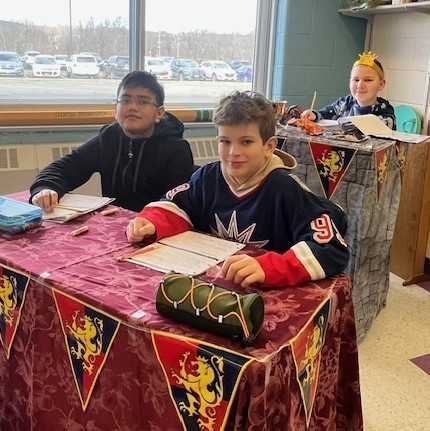





How do art and music and art manipulate emotions?
IS Music Teacher Deanna Feuerbach and IS Art Teacher Joan Giardina recently explored connections in music and art with their fifth-grade students in companion “specials” lessons! What a great, creative idea!
In music class, Ms. Feuerbach asked students to name three emotions that music can make one feel, or three things it can make on thing of. Then, she asked them to name three things in music that can have an effect on the feeling of the music.
Later, she spoke about the concept of synesthesia, which in music means experiencing music with other senses, like seeing colors when they hear notes or feeling a physical sensation from the music, rather than just hearing it. Some musicians and composers have a form of synesthesia that allows them to "see" music as colors or shapes. This is called chromesthesia. Mozart and Kandinsky are said to have had this form of synesthesia.
Students then took a look at Wassily Kandinsky's 1925 painting "Yellow Red Blue" that was painted in 1925. Kandinsky heard music when he painted with different colors and shapes, and he also felt different emotions for each color and shape he painted. In this activity, the students were able to interact with "Yellow Red Blue" on the promethean board, listening to Kandinsky's painting as he may have heard it. The different shapes and colors represent different instruments and emotions. The students were asked to describe the sounds and emotions they heard when playing with "Yellow Red Blue"
Meanwhile, in art class, Mrs. Giardina tasked her students to select four different types of “lines” and draw four color circles. For each she asked them to describe the kind of emotions they represented. She, too, spoke about synesthesia in art, which means experiencing one sense through another, like seeing colors when you hear music or smelling a color. It's a fun way to explore how brains connect different senses and can inspire unique artistic expressions.
Then they spoke about the applying their line designs to music. What emotions or feelings does it evoke? What comes to mind when thinking about the music. If they were to represent the feel of the music visually, what types of lines or colors would they use?
Then, they were tasked with sketching their ideas using thin, thick, straight, curved, solid and/or interrupted lines. Their work is amazing, and like in music class…. there’s no wrong thoughts or answers! Everyone sees and feels things differently!







